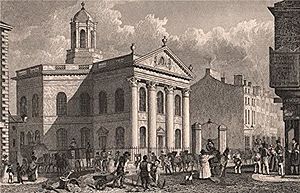Hope Street Unitarian Chapel facts for kids
Hope Street Chapel was a special church in Liverpool, England. It was a Unitarian place of worship. This means it was a church for people who follow Unitarian beliefs. The chapel was located on Hope Street. It was right next to the famous Philharmonic Hall, Liverpool. It stood almost exactly between Liverpool's two big cathedrals, the Anglican and Catholic ones. Before moving to Hope Street, the church community met in Paradise Street. Even before that, they were in Kaye Street. The Hope Street Chapel first opened its doors in 1849. It was later taken down in 1962.
Contents
The Chapel's Journey: A Look at Its History
Early Beginnings in Kaye Street
The story of Hope Street Chapel began a long time ago. In 1709, a group of Presbyterian churchgoers met in Kaye Street, Liverpool. Christopher Bassnett became their minister that year. He led the congregation until he passed away in 1744. From about 1729, John Brekell helped him.
After Bassnett, John Brekell became the main pastor. He continued to lead the church until he died in 1769. Philip Taylor, who had been his helper since 1767, took over next. This happened after a time when Presbyterian groups in the city were not as strong.
Moving to Paradise Street
In 1777, John Yates became the minister at the Kaye Street Chapel. He was a Unitarian. In 1791, the church community moved with him. They moved to a new building called Paradise Street Chapel. John Yates retired from his role there in 1823.
After Yates, Pendlebury Houghton was the minister for about a year. Then, John Grundy took over. In 1832, James Martineau joined Grundy as a fellow minister. Grundy was not in good health, so he stepped down in 1835. Martineau then had a new church built in 1848. This new church was in Hope Street. The congregation moved there, and it became known as Hope Street Chapel.
Ministers at Hope Street Chapel
James Martineau left Hope Street Chapel in 1857. After him, several other ministers led the church until 1883. They included:
- William Henry Channing
- Charles Wicksteed
- Alexander Gordon
- Edmund Martin Geldart
- Charles John Perry (who served from 1852 to 1883).
Other Unitarian Churches in Liverpool
If you are interested in other Unitarian churches in Liverpool, you might want to learn about these:


